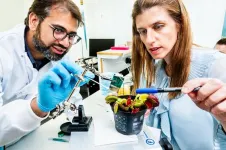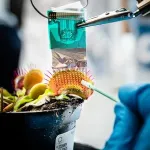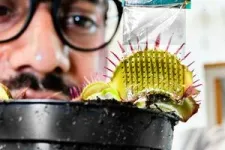(Press-News.org) What happens inside the carnivorous plant Venus Flytrap when it catches an insect? New technology has led to discoveries about the electrical signalling that causes the trap to snap shut. Bioelectronic technology enables advanced research into how plants react to their surroundings, and to stress.
Most people know that the nervous system in humans and other animals sends electric impulses. But do plants also have electrical signals even though they lack a nervous system? Yes, plants have electrical signals that are generated in response to touch and stress factors, such as wounds caused by herbivores and attacks on their roots. As opposed to animals, who can move out of the way, plants must cope with stress factors where they grow.
“There is currently a great need for developing plants that are more stress resistant, for us to be able to grow food and have healthy forests also in the future. That’s why it’s important that we understand how plants respond to stress, and I think that this new technology may contribute in this area of research.” says Eleni Stavrinidou, associate professor in the Department of Science and Technology at Linköping University, Sweden, and leader of the Electronic Plants group.
It turns out that in some plants electrical signals are correlated with rapid movements. The carnivorous plant Venus Flytrap (Dionaea muscipula) is used by researchers as a model system for fast electrical signalling in plants.
The inner side of the Venus Flytrap trap has small sensory hairs. The bending of a hair, for example by an insect, may cause the trap to snap shut. The animals caught are then broken down by an enzyme in the trap, and the plant absorbs the nutrients. But for the trap to close, the sensory hairs need to be touched twice within about 30 seconds. This way, the plant can save energy by not snapping shut every time a hair is stimulated by things other than potential prey.
Electrical signalling in living organisms is based on a difference in voltage between the inside of cells and the outside environment. This difference in voltage is created when ions, i.e. electrically charged atoms, are moved between the inside and the outside of the cell. When a signal is triggered – for instance by mechanical stimulation in the form of bending a sensory hair – ions flow very fast through the cell membrane. The rapid change in voltage gives rise to an impulse that is propagated.
There is ample knowledge about how nerve impulses function in humans and other animals. But when it comes to plants, which do not have a nervous system, a lot remains to be discovered.
In their study, published in Science Advances, the researchers demonstrate a multi-electrode array technology that is used to examine the emergence and propagation of the electrical signal in a Venus Flytrap. This new technology was developed by researchers at Linköping University in collaboration with researchers from Columbia University, who use this technology for neuroscience studies in animals.
The newly developed measuring device consists of a very thin film with electrodes in it. As it is roughly as thin as plastic wrap used for covering food, it follows the curvature of the outside of the plant’s lobes. The researchers poked a sensory hair and, using around 30 electrodes, measured the signal in the lobe. They also filmed the plant’s movements, to be able to correlate the electrical signal with the closure of the Venus Flytrap.
In previous research most often only one measuring point was used, which did not allow for pinpointing the origin of the signal, nor its directions of propagation.
“We can now say with certainty that the electrical signal originates in the sensory hairs of the Venus Flytrap. With our technology, we can also see that the signal mainly spreads radially from the hair, without any clear direction,” says Eleni Stavrinidou.
The new measuring technology also lets the researchers discover new information.
“As we could measure signals from the entire trap, we see that signals are sometimes spontaneous and come from sensory hairs that were not stimulated. This is very interesting, and we don’t know yet why this happens or what the function is. One of the most important aspects of this study is that we show that bioelectronic technologies, which are extensively used in biomedical research, can be applied to plant physiology research as well, therefore opening possibilities for new discoveries” says Eleni Stavrinidou.
The research has received funding from the Swedish Foundation for Strategic Research, the EU Horizon 2020 Research and Innovation Programme, and the Swedish Government Strategic Research Area in Materials Science on Advanced Functional Materials (AFM) at Linköping University.
END
Fast electrical signals mapped in plants with new bioelectronic technology
2023-07-26
ELSE PRESS RELEASES FROM THIS DATE:
Aphids make tropical milkweed less inviting to monarch butterflies, study finds
2023-07-26
Many gardeners will tell you that aphids are the bane of their existence. According to a new study from the University of Florida, these tiny pests also pose problems for the iconic monarch butterfly. The study found that when oleander aphids infested tropical milkweed — a nonnative milkweed species commonly used across southern portions of the U.S. stretching from California to Florida — the butterflies laid fewer eggs on the plants, and caterpillars developing on those plants were slower to mature.
Monarch butterflies depend on milkweed and its close relatives to complete their life ...
Climate change threatens 771 endangered plant and lichen species
2023-07-26
All plants and lichens listed as endangered under the Endangered Species Act are sensitive to climate change but there are few plans in place to address this threat directly, according to a new study by Amy Casandra Wrobleski of Pennsylvania State University and colleagues, published July 26, 2023 in the open-access journal PLOS Climate.
Climate change is expected to have a major impact on species around the world, especially endangered species, which are already rare. A majority of the organisms listed under the Endangered Species Act are ...
Increased step count linked to better health for people with heart failure
2023-07-26
More often, people are turning to consumer wearable devices, such as smartwatches, to monitor their health and physical activity.
Using these wearable devices, a study led by Michigan Medicine and the University of Missouri with Saint Luke’s Mid America Heart Institute finds that taking more daily steps is associated improved health, including fewer symptoms and physical limitations, for people with heart failure. The results are published in JACC: Heart Failure.
Clinicians are increasingly presented with their patients’ wearable device data, ...
NIH spent $950M for basic or applied research leading to patents providing market exclusivity for drugs approved 2010-19
2023-07-26
BENTLEY UNIVERSITY
A new study from Bentley University’s Center for Integration of Science and Industry demonstrates that the National Institutes of Health (NIH) spent $950 million on basic or applied research associated with patents that provided manufacturers with market exclusivity. This amount represents <1% (0.59%) of the $164 billion in total NIH funding for research contributing to the approval of these products.
The article in PLOS ONE titled “NIH funding for patents that contribute ...
People with heart failure can step their way to better health
2023-07-26
People with heart failure who increase their daily step count also saw improvements in their health status over a 12-week period, according to a study published today in JACC: Heart Failure. The study suggests that physical data from wearable devices, such as step count, can be clinically significant and has the potential to inform future clinical trials and clinical care.
Consumer wearable devices to track health status and progress are commonly used and part of a growing trend of mobile health technology. However, how to interpret data from wearable devices, including step count, is at times ...
Ancient DNA reveals diverse community in “Lost City of the Incas”
2023-07-26
Who lived at Machu Picchu at its height? A new study, published today in Science Advances, used ancient DNA to find out for the first time where workers buried more than 500 years ago came from within the lost Inca Empire.
Researchers, including Jason Nesbitt, associate professor of archaeology at Tulane University School of Liberal Arts, performed genetic testing on individuals buried at Machu Picchu in order to learn more about the people who lived and worked there.
Machu Picchu is a UNESCO World Heritage Site located in the Cusco ...
Essential cell death-regulating mechanisms important for recovery from SARS-CoV infection and skin injury discovered
2023-07-26
Programmed cell death, a fundamental biological process that facilitates the elimination of old, damaged, infected, and non-functional cells, plays a crucial role in maintaining the balance between health and disease in the human body. Research by the team of Dr Alessandro Annibaldi from the Center for Molecular Medicine Cologne (CMMC) at the University of Cologne has uncovered a novel mechanism of cell death regulation, shedding light on its significance during conditions such as SARS-CoV infection and skin injury. The study ‘Cleavage ...
DNA analysis offers new insights into diverse community at Machu Picchu
2023-07-26
New Haven, Conn. — A genetic analysis suggests that the servants and retainers who lived, worked, and died at Machu Picchu, the renowned 15th century Inca palace in southern Peru, were a diverse community representing many different ethnic groups from across the Inca empire.
The genomic data, described in a new study in Science Advances, is the first investigation of the genomic diversity of individuals buried at Machu Picchu and adjacent places around Cusco, the Inca capital. It builds upon previous archeological and bio-archaeological research, including a 2021 Yale-led study which found that Machu Picchu (AD 1420-1530) is older than was previously believed.
“The ...
Lost metabolic fitness of CAR NK cells is key mechanism of tumor resistance
2023-07-26
A new study led by researchers at The University of Texas MD Anderson Cancer Center discovered loss of metabolic fitness in chimeric antigen receptor (CAR) natural killer (NK) cells is a critical mechanism of resistance, with infused cells gradually losing the ability to compete with tumor cells for nutrients, leading to tumor relapse.
The study, published today in Science Advances, demonstrates that engineering CAR NK cells to express interleukin-15 (IL-15) enhances the cells’ metabolic fitness and provides a longer-lasting ...
Researchers develop machine learning models that could improve suicide-risk prediction among children
2023-07-26
A new study from UCLA Health researchers finds that the typical ways health systems store and track data on children receiving emergency care miss a sizable portion of those who are having self-injurious thoughts or behaviors. The researchers also found that several machine learning models they designed were significantly better at identifying those children at risk of self-harm.
Amid a nationwide youth mental health crisis, mental health providers are trying to improve their understanding of which children are at-risk of suicide or self-harm so providers can intervene earlier. However, health systems often ...



